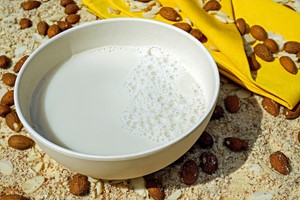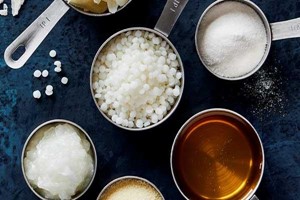Beverages based on rice, nuts, grains and/or soybeans (RNGS) are among the fastest growing in many markets today and forecasts indicate that growth will be sustained or even increase. This is an exciting product group that involves almost endless possibilities for new formulations and combinations. The RNGS raw materials represent a wide spectrum of characteristics. It is not only hundreds of different ingredients and thousands of different combinations of raw materials that are used. One must also take into account the variations depending on the season, growing conditions, where the crop is grown etc. All in all, this means new challenges for the lab, for example when it comes to assessing shelf life stability of these products. A development of the NIZO-method for measuring homogenization efficiency in dairy milk has shown promising results for the assessment of two important parameters for shelf life stability in RNGS beverages, namely creaming and sedimentation. Properly used, calibrated and correlated to real time storage tests, this method – the RNGS stability test – has the potential to serve as an important aid in product development by giving crucial input to the assessment of a product's life cycle. Also, this quick, simple and effective method for measuring homogenization efficiency can contribute to minimizing the need for additives such as stabilizers and emulsifiers, at the same time reducing energy costs.
Advantages of an accelerated method
The only completely reliable way to assess shelf life stability of a product is to simply put it on the shelf and wait. Analyzing the product periodically will provide an answer whether a particular product survived one, two, three, or maybe six months on the shelf without unacceptable changes. It goes without saying that this very time-consuming method means limitations in, for example, product development, where it would be of tremendous help being able to quickly and safely obtain reliable data on how a product or a slightly modified formulation behaves in storage. The same applies in the continuous quality control, where seasonal variations or change of supplier may mean that the process must be adjusted for the product to maintain consistent and high quality over time. An important parameter for determining a product's shelf life stability is to measure homogenizing efficiency. Today there is a variety of methods for making such measurements.
The most common is the so called NIZO method, which involves centrifuging a sample of milk for 30 minutes and then dividing the fat content of the bottom layer with the fat content of the whole sample. By multiplying the quota by 100, an index is obtained. The higher the index, the more efficient the homogenization. A typical NIZO index of pasteurized milk is 50-80. Unfortunately, this method does not provide the necessary information about RNGS products. For the consumer, RNGS products usually appear as simple and natural. Rice, nuts, grains and/or soybeans that are processed just enough to retain their taste, their nutritional content and other good qualities. These are also important selling points behind the products rising popularity. But if you look at these products from a food processor´s perspective, they are often anything but simple.
It places great demands to scale up for example a peanut or cashew nut milk from small scale preparation to an industrially processed, attractive product with high and consistent quality, ready for the mass market. Formulations with input of multiple raw materials, with completely different characteristics, also mean both new opportunities on the market and challenges for the production processes. Two typical characteristics of RNGS-products are that they contain particles that will cause sedimentation and that the fat that they contain tends to give rise to so called creaming. Sedimentation is a minor problem, as ”shaking the container” is today a learned and accepted consumer behaviour - just as one shakes a pack of, for example, orange juice containing pulp and fibre. Provided that the sediment hasn´t formed a hard bottom layer, the shaking will restore the emulsion and the product will be perceived as smooth and fine. Creaming, on the other hand, is a bigger problem, partly because the fat bubbles that may form do not dissolve as easily and, in addition, are perceived as unappetizing both in appearance, taste and mouthfeel. The more stable a product is over its shelf life cycle, the less problems will be caused by sedimentation and creaming, and an important key is to strike the right homogenization efficiency. With the right homogenizing efficiency, both sedimentation and creaming can be maintained at controlled, foreseeable and acceptable levels. The product can be given the right quality with respect to the sensory characteristics - taste, mouthfeel, viscosity, etc. - without "unnecessary" additives such as stabilizers and emulsifiers. Also, ”over-homogenization” can be avoided, meaning both higher product quality and reduced energy costs. But the characteristics and properties of a product at the moment it leaves the production line is one thing. How it tastes and is perceived when it finally reaches the consumer after a shorter or longer period on the store shelf can unfortunately be something completely different. For product developers and quality managers, it is therefore of great importance to be able to predict how a product is maintained over time. To simply place a product on the shelf and wait is an option, but not an effective one.


The product developer wants to be able to experiment with different formulations and quickly get an answer, and there are also other obvious reasons for being able to assess the product´s shelf life stability before placing it on the market. A further development of test methods used to measure homogenization efficiency has shown to give results that correlate with real-time storage and could be a major step on the road to obtain an objective measurement of shelf life stability of RNGS products.
The RNGS stability test in brief
The method, developed in collaboration with two world leading producers of RNGS products, aims to objectively predict the shelf life stability without a need of real-life storage tests. The problem to solve has been whether it is possible to achieve correlation between a fast and effective method – an "accelerated" test of various products and values – and the same products stored under various periods of time. The test method has been developed for measuring two different parameters, namely, particle sedimentation and creaming. Here we describe two typical results of accelerated and real-time tests of peanut milk and soymilk.
- Particle sedimentation in peanut milk A fresh sample was centrifuged for 15 minutes with a G-force from 10 to 1.000g. The sample was then divided into three parts - top, middle and bottom and particle size analysis D[5,3] was performed on the top layer. For correlation, the results were compared with particle size analysis results of the same products after different times of storage. The theory behind using only the top layer to assess sedimentation – instead of the bottom layer, where the most of the sedimentation collected – is that the top layer is changing most rapidly, both during centrifugation and storage. By analyzing the presence of particles after centrifugation at different speeds and lengths of time, one can determine how sedimentation will occur in the product.
- Soy milk creaming Fresh samples of soymilk were centrifuged to 1.000 to 2.000g for 15 and 30 minutes respectively. The samples were then divided into five layers. Particle size analysis was performed on the bottom layer. By analogy with the theory behind the particle sedimentation analysis, the theory behind this is that the fat globules leave the bottom layer most quickly, so by examining this layer the degree and speed of the product creaming can be examined. These tests have been correlated with samples of products stored for different lengths of time.
Discussion
The attempts made to obtain a quick, simple and safe method for the objective assessment of shelf life stability of RNGS products have so far yielded very promising results. With proper calibration and further testing, there are strong indications that centrifugation and sample analysis according to the method described above will be useful to reduce the need for time-consuming real-time shelf life stability tests considerably. Today there are correlated values for a number of products and this number is growing constantly. But for the method to become truly useful and accepted, further testing and development work is required, with the task to establish exact correlations between the accelerated test results and storage tests. A desirable scenario would be that the method was spread, used and evaluated by producers of RNGS beverages around the globe. In this way, the method can be refined while an increasingly large database containing reliable shelf life stability numbers products with different ingredients and formulations can be built up.
Tetra Pak














